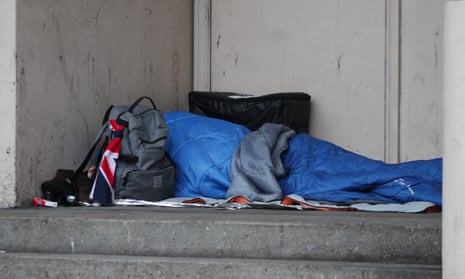The “hidden crisis” of rural homelessness requires urgent attention from the government, a leading thinktank has said after research revealed a dramatic rise in the number of rough sleepers in countryside areas in the last five years.
The Institute for Public Policy Research warned that it is particularly hard to prevent or relieve because of the difficulties in covering larger areas and the lack of specialist resources compared to cities.
It said the number of people sleeping rough in barns, outhouses and parked cars in rural areas had risen by up to 32% between 2010 and 2016.
The report, Right to home? Rethinking homelessness in rural communities, finds the promotion of the countryside as a “rural idyll” where people go to escape the city and have a better life could “mask” the presence of households at risk of becoming homeless or already without a roof over their heads.
The research – which was commissioned by Hastoe, a leading rural specialist housing association – found that 6,270 households were accepted as homeless in 91 mainly or largely rural local authorities in England in 2015-16, an average of 1.3 in every 1,000 households.
A fifth of all homeless cases occurred outside of England’s most urban areas. From 2010 to 2016, “mainly rural” local authorities recorded a 32% rise in cases of homelessness. In areas that are “largely rural” there has been a leap of 52%, and an almost doubling in “urban areas with significant rural” (97%).
IPPR research fellow Charlotte Snelling said a lack of research on the topic prompted them to see whether homelessness actually was a problem. “There is nothing really out there about it,” she said. “It isn’t really talked about and it’s not very visible. But we found that even though you don’t actually see it in the same way as homelessness in cities, it is actually quite prevalent.
“In cities, you see people sleeping in shop doorways and you don’t see that so much in rural areas as there are alternatives which are off the beaten track such as tents in wooded areas and outhouses.”
Preventing and relieving homelessness can be especially difficult in rural areas, Snelling said, because of a relative absence of emergency hostels and temporary accommodation, large travel distances with limited public transport, isolated and dispersed communities, and constrained resourcing for specialist services.
Snelling said: “Rural homelessness often goes undetected but that doesn’t mean it isn’t happening and unless you tackle the difficulties in delivering services in rural areas and finding affordable homes, it will continue to be a problem.”
Jacob Quagliozzi, director for Housing Justice England, a Christian housing charity, said there has been a rise in churches and community groups contacting them for advice on setting up night shelters in their buildings.
The demand for emergency accommodation provision has seen “substantial growth” outside of the big cities, Quagliozzi said.
“We have seen a dramatic increase over the last 18 months of faith and community groups in non-urban areas coming to us for advice on setting up a night shelter,” he said. “Some of these are places that have little experience in recent history of rough sleeping, or only have small scale historic provision which is no longer sufficient to meet increasing need or which has seen its funding reduced.
“As welfare policies make it increasingly difficult for people to afford to live in the inner city these are trends that may increase. The gaps in verifiable data for homelessness outside of big cities, as outlined by IPPR, is a significant issue that hampers effective targeting of resources and policy makers need to address.”
In Staffordshire, Burton upon Trent and district YMCA provides a variety of services for homeless people in the town and the surrounding countryside. Chief executive Paul Laffey has been working in homelessness for 18 years and says his charity has seen a significant rise in cases in the last three to four years.
Laffey has employed staff to go into rural areas, providing an outreach service. “It could be 4am or 5am in the morning and we have been able to identify specific hotspots of areas such as a rugby ground where people would bed down in the stands,” he said.
“We have also found people sleeping in cars and disused buildings and even one who was sleeping on a flat roof of a local community hall.”
The charity has 71 beds in the town at different locations but they are “constantly full” and that people walk for miles across the countryside just to access their services.
The IPPR is calling for central government to develop a new national homelessness strategy, taking the enactment of the Homelessness Reduction Act 2017 as its lead, and which must include rural-specific consideration and guidance.
The report also recommends that local authorities should enter into two-way negotiations with the government to develop devolution deals on housing and planning in which ambitious commitments to increasing affordable supply should be met with a transferral of power to do so.
Matt Downie, director of policy and external affairs at Crisis, said rough sleeping is continuing to rise at an appalling rate. He said: “As this report shows, out of sight of the official statistics, many more people are struggling in hidden situations, sleeping in doorways, cars, tents or barns – basically anywhere they can find to stay safe and escape the elements.
“Rough sleeping ruins lives, leaving people vulnerable to violence and abuse, and taking a dreadful toll on their mental and physical health. Tragically, the average age of death for a homeless person is just 47 and they are 17 times more likely to be victims of violence. This is no way for anyone to live.
“There’s no time to waste. We need concerted national action to end rough sleeping once and for all, wherever it happens.”
